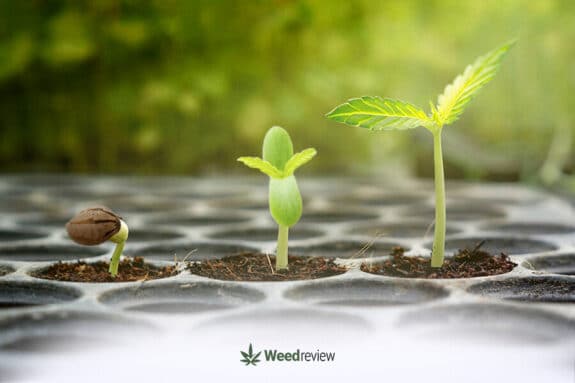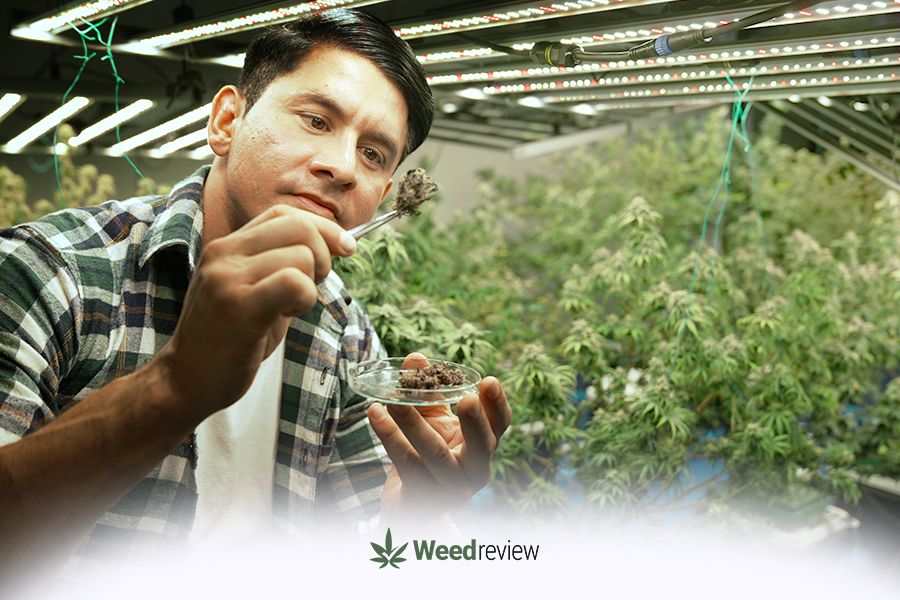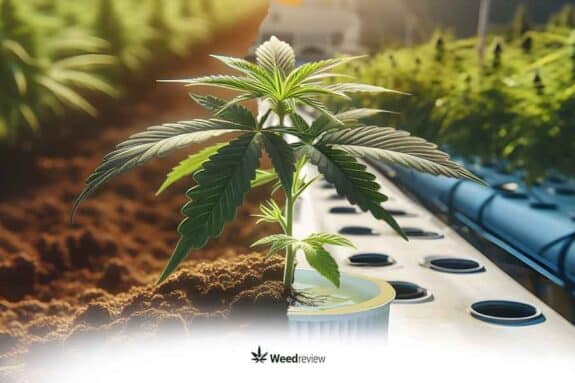
How to Grow Cannabis Indoors: A Comprehensive Guide to Indoor Marijuana Cultivation

Table of Contents
Growing cannabis indoors offers several advantages, including greater control over the growing environment, increased privacy, and the ability to cultivate year-round. As a result, indoor growing is a popular choice for growers seeking high-quality marijuana.
In this guide, we’ll talk about everything from choosing the ideal strain to setting up your grow space, optimising lighting, mastering watering routines, and ultimately harvesting your crop.
We will provide you with the knowledge and tips needed to cultivate top-notch medical cannabis in the comfort of your own home.
What you need to consider
Starting indoor cannabis growing? You’ll need to think about a few key things.
First, because there’s no natural sunlight, you’ll need special lights to mimic the sun.
Next, you’ll need to keep an eye on things like where you grow, how warm or humid it is, the airflow, and what nutrients you give your plants. Picking the right type of cannabis, the best pots, and when to water are all important too. Get all this right, and your cannabis plants should thrive.

The sections below explore these concepts in detail.
Location
Selecting the right indoor location for successful cannabis cultivation is crucial. Every grow space is unique, so consider your specific needs and preferences for a successful indoor cannabis cultivation experience.
Here are key factors to consider:
- Space size: Ensure enough room for plants, equipment, and ease of work. Space size determines plant capacity.
- Ventilation: Prevent humidity and heat buildup with proper airflow. Plan intake and exhaust fan placement to avoid mould and mildew.
- Lighting: Ensure space accommodates your chosen lighting system (HID, LED, or CFL) at the right distance for optimal light intensity.
- Electricity: Ensure ample outlets and capacity for lights, fans, and equipment. Consider surge protectors or dedicated circuits.
- Privacy/security: Select a discreet location with security measures if needed to protect your plants.
- Water source: Easy access to water for regular watering or automated system.
Grow tent
A grow tent is like a special house for growing cannabis indoors. It’s a portable and enclosed space that helps create the perfect environment for plants to grow. The tent is made of fabric that reflects light, keeping it inside and helping plants absorb it.
It also has zippers and vents for easy access and airflow. You can set up lights, fans, and filters inside the tent to replicate the sun, fresh air, and other conditions for a high yield.
Humidity control
The health and growth of cannabis plants hinge significantly on maintaining the right humidity and temperature. For indoor growers, here’s what you need to target at each growth stage:
- Germination stage:
Humidity: 70-90%
Temperature: 21-29°C
- Seedling stage:
Humidity: 65-70%
Temperature: 21-24°C
- Vegetative stage:
Humidity: 40-70%
Temperature: 21-29°C
- Flowering stage (early):
Humidity: 40-50%
Temperature: 20-25°C
- Flowering stage (late):
Humidity: 30-40%
Temperature: 18-24°C
Using a dehumidifier becomes important to manage humidity and avoid problems like mould growth and bud rot. Similarly, if you need to add humidity, then a humidifier works wonders by putting moisture back into the air.
For Thailand, given the highly humid conditions, a dehumidifier is a must-have when cultivating marijuana indoors.
Lighting
When cultivating cannabis indoors, artificial lighting becomes your plants’ main energy source, replicating the sun’s vital role. This means understanding the types of lights and their uses, the correct light cycles, and the automation of these cycles is essential for a successful harvest.
Types of lights
Choose from various lighting options such as LED (Light Emitting Diode), HPS (High-Pressure Sodium), and fluorescent lights.
- LED (Light Emitting Diode): LEDs are celebrated for their energy efficiency and full spectrum of light. These qualities make them versatile and suitable for both vegetative and flowering stages.
- HPS (High-Pressure Sodium): Known for their high-intensity output and red spectrum, HPS lights are often chosen for the flowering phase to boost bud development.
- Fluorescent lights (e.g., T5s): With a cooler operation, fluorescent lights are especially good for seedlings and young plants, helping them grow without the risk of heat stress.
Light cycles
Understanding and implementing proper light cycles is important for proper growth.
- Vegetative phase: Typically, cannabis plants in their vegetative state thrive with 18 hours of light, followed by a short period of 6 hours of darkness.
- Flowering phase: When it’s time for them to flower, adjust the cycle to 12 hours of light and 12 hours of darkness. This shift cues the plants to start producing flowers.
Timers are helpful in this regard for automating light cycles. They ensure consistent, precise lighting durations for plants at different growth stages, promoting healthy development and maximising yields.
Light intensity & distance
As your plants grow, the distance and intensity of your lights may need adjustments. Remember, plants can get sunburned.
Keeping them too close can burn the plants, while having them too far away can reduce the light plants receive, hampering growth.
If you notice the leaves turning yellow or looking bleached, especially those closest to the lights, they might be too close and receiving too much intensity. On the flip side, if your plants’ stems are elongating and appearing weak with wider spacing between leaves, they might be stretching to get closer to the light, indicating the lights might be too far.
A good rule of thumb is to place your hand at the canopy level of your plants; if it feels too hot for your hand, it’s probably too hot for your plants. Regular checks and adjustments, especially during rapid growth phases, will ensure your plants thrive in the best lighting conditions.
Ventilation and airflow
Ever been in a stuffy room with no air movement? It’s not comfortable. For cannabis, stagnant air isn’t just uncomfortable; it’s harmful. Lack of airflow can create a haven for mould, mildew, and pests.
Here is how a well-ventilated environment helps your marijuana plants indoors:
- Moist, still air is a playground for mould. Ensure your space has constant, even airflow. Not a hurricane, just a nice steady breeze that keeps the air fresh and prevents pockets of humidity.
- Proper ventilation can help deter unwelcome visitors like thrips or mites. Maintaining good airflow makes it harder for these tiny threats to settle and reproduce.
- Odour control is another important aspect of ventilation, especially if you have nosy neighbours. Carbon filters, combined with fans, stop the strong odours that cannabis plants can emit during flowering.
When setting up, consider how the air will flow. Intake fans usher in that all-important fresh air, while exhaust fans expel the old. This isn’t just about oxygen; it’s about the CO2 exchange essential for photosynthesis. Your plants inhale CO2 and exhale oxygen. Make sure they always have a fresh supply.
Proper ventilation allows for an air exchange, bringing in fresh CO2 and expelling the CO2-depleted air. This gives your plants all the CO2 they need to grow.
The legal picture: Can you grow weed indoors in Thailand?
Yes, it is legal to grow weed at your home in Thailand. Cannabis was decriminalised in 2022, and one of the provisions was personal cultivation.
The rule is applicable to Thai citizens only. The citizens must sign up and register on the government-operated Plook Ganja app to get the necessary documentation for home grow.
Essential equipment for indoor cannabis cultivation
Beyond foundational tools such as lights and fans, several pieces of equipment can significantly refine the environment for indoor marijuana.

Humidifiers
In areas with dry climates or during the colder months, a humidifier can be instrumental. During the seedling and vegetative stages, cannabis plants thrive in higher humidity. A humidifier can help you achieve and maintain these optimal conditions.
Dehumidifiers
As your plants transition to the flowering phase, a drier environment becomes crucial to reduce the risk of mould and mildew. A dehumidifier can efficiently lower excessive moisture in your grow room.
Thermostats and hygrometers
To keep a consistent check on your grow space’s temperature and humidity, these tools are invaluable. Digital devices often combine these features, offering real-time insights into the environmental conditions of your space.
pH meters
Through pH, we understand the mix of acidity and alkalinity in our soil, which affects how plants absorb nutrients. Monitoring the pH is crucial; if it is too high or too low, the plants will not absorb the necessary nutrients needed for healthy growth.
High-quality pH meters can provide accurate readings, ensuring the right balance for your plants.
Oscillating fans
While fans are already discussed, oscillating fans deserve mention for their ability to distribute air more evenly, ensuring there are no stagnant zones in the grow space.
Strain selection
Genetics plays a significant role in the characteristics and performance of cannabis plants. Understanding the different genetic types will help you make an informed choice for your indoor growing process.

Genetics
When selecting a strain for your indoor grow, start by understanding the genetic differences between Sativas, Indicas, and hybrids.
- Sativa strains: Are known for their uplifting, energising effects and tend to grow taller.
- Indicas: Offer relaxation and are typically shorter.
- Hybrids: Combine traits from both, providing a balance between relaxation and energy.
Consider your desired effects and the available space when choosing a genetic profile that suits your needs.
Autoflowering
Another important consideration is whether you want autoflowering strains. These varieties automatically transition from the vegetative stage to flowering without relying on light cycles.
This saves time and simplifies the growing process. Autoflowering strains are perfect for beginners and those with limited grow space.
Yield and size
Take into account the plant’s growth characteristics and yield potential. Some strains produce smaller, dense buds, while others yield larger, airy ones. Consider your available space and how much you want to harvest when making your selection. High-yielding strains can maximise your indoor garden’s productivity.
Odour control
For discreet indoor growing, choose strains with less pungent aromas. Some strains have strong, distinctive scents that can be challenging to mask. Research strains with milder odours or consider using odour-control methods to maintain a low profile while growing indoors.
Recommendations
- Indica-dominant hybrid: If you’re new to growing, consider an Indica-dominant hybrid like Blue Dream for its balanced effects and manageable size.
- Auto-flowering strain: Northern Lights Auto is an excellent autoflowering choice, known for its easy cultivation and potency.
- High-yield option: Opt for Girl Scout Cookies if you’re looking for a high-yielding strain with a well-rounded genetic profile.
- Low-odour variety: Blue Mystic is a low-odour strain suitable for discreet indoor cultivation.
Remember that personal preferences and growing conditions vary, so research and experimentation are key to finding the perfect strain for your indoor growing.
Growing medium
Selecting the appropriate growing medium is vital for healthy plant growth.
The growing medium serves as the foundation for your plants, providing essential support, nutrients, and moisture. There are various options to consider when choosing a growing medium, and each has its advantages and disadvantages.

Soil vs. hydroponics
Soil and hydroponics are two of the most common growing mediums for indoors.
When deciding between soil-based and hydroponic systems, it’s essential to weigh the features and benefits of each:
Soil-based systems
- Nutrient availability: Soil naturally contains a range of nutrients that plants need for growth. These nutrients are released gradually, ensuring a steady supply for the plants over time.
- Microbial activity: Soil fosters a complex ecosystem of microorganisms that aid in nutrient cycling and disease suppression, promoting healthier plant growth.
- Cost-effective: Soil is generally more affordable than hydroponic setups, making it an accessible option for many gardeners.
Hydroponic systems
- Precise nutrient control: Hydroponics allows for precise control over nutrient levels, ensuring plants receive exactly what they need for optimal growth.
- Water efficiency: Hydroponic systems use water more efficiently than soil, making them an eco-friendly option and reducing water waste.
- Faster growth: Plants in hydroponics often grow faster due to the direct availability of nutrients and consistent environmental conditions.
- Higher costs and expertise: Hydroponic systems are better suited when you are more experienced with growing weed or can make an investment in the equipment.
The choice between soil-based and hydroponic systems depends on your specific goals, resources, and preferences.
Other mediums
Beyond traditional soil and hydroponics, there are other growing mediums that cultivators can consider. Here’s a rundown:
- Coco Coir: Derived from coconut husks, this natural fibre balances water retention and aeration. Suited for both soil and hydroponic systems.
- Perlite and vermiculite: Mineral-based additives that boost aeration and moisture in potting mixes. Perlite aids drainage; vermiculite retains water.
- Rockwool: Melted rock and sand spun into fibres. Popular in hydroponics for its water and air balance. Requires pH adjustment.
- Peat Moss: A natural sponge-like material, great for moisture retention but can be acidic.
- Expanded Clay Pellets (Hydroton/LECA): Round balls made from clay, ideal for hydroponics due to water and airflow balance.
Growing containers
Choosing the right container is pivotal for indoor cannabis growth. From traditional pots to advanced systems, each type offers unique benefits. Let’s explore the options to ensure optimal plant health and yield.
- Traditional Pots: Often made from plastic or terracotta. They are versatile but ensure they have proper drainage.
- Fabric Pots: Promote better aeration to roots and prevent overwatering due to their breathable nature.
- Air Pots: Designed with openings on the sides to enhance root pruning and provide increased aeration.
- Smart Pots: A type of fabric pot that promotes robust root growth by air-pruning the roots when they reach the container’s edge.
- Hydroponic Containers: Used for hydroponic systems, they allow plants to grow directly in water or another non-soil medium.
Consider the following factors when choosing containers:
- Plant type: Different plants have varying root system sizes. Research the specific needs of the plants you intend to grow and choose containers accordingly.
- Root development: Container size directly impacts root health. Small containers can restrict growth, while too-large containers risk overwatering and wasted space.
- Space: Match container size with your grow area. Compact spaces may need smaller pots, whereas spacious rooms can host larger ones.
- Drainage: Ensure that containers have proper drainage holes to prevent waterlogging, as this can damage root health.
Nutrient management: What do your cannabis plants need?
Cannabis plants have evolving nutrient needs as they grow from seedling to vegetative and flowering stages. Adjusting nutrient ratios accordingly is essential for healthy growth and maximising yields.
Here are the general guidelines:
- Seedling Stage: At this initial phase, the fragile roots of cannabis plants require gentle feeding. Opt for a balanced, low-intensity nutrient mixture, such as a 2-1-1 (N-P-K) ratio, emphasizing slightly more Nitrogen for foundational vegetative growth.
- Vegetative Stage: Here, the plant focuses on developing lush foliage and robust roots. A higher Nitrogen concentration is beneficial, so a 3-1-2 (N-P-K) ratio, emphasizing Nitrogen, often works well.
- Flowering Stage: As plants usher into the flowering phase, their nutrient priorities shift. To support bud and flower development, lower the Nitrogen intake while ramping up Phosphorus and Potassium. Ratios like 1-3-4 (N-P-K) or even 0-5-4 (N-P-K) can be effective.
Beyond the primary N-P-K ratio, it’s essential to consider other vital macronutrients like Calcium (Ca), Magnesium (Mg), and Sulfur (S), as well as essential micronutrients like Iron (Fe), Manganese (Mn), and Zinc (Zn) which play crucial roles in plant health.
Not supplying these in the right quantities or balance can lead to nutrient deficiencies, manifested as yellowing leaves, stunted growth, or poor bud development. To ensure optimal growth, it’s crucial to regularly inspect plants for such signs and adjust nutrient levels accordingly.

Buying pre-mixed nutrients
Pre-made cannabis nutrients, also called pre-mixes, are ready-to-use products designed for each growth stage. They come in liquid or powder forms, usually mixed with water. These nutrients are precisely formulated to ensure the right nutrients in the correct ratios, promoting healthy growth and high yields.
Manufacturers offer detailed instructions and schedules for feeding, maintaining nutrient balance, and optimising plant potential. This provides growers with a convenient and dependable way to nourish their cannabis plants throughout their growth cycle.
Preparing your own nutrient mixture
While pre-made cannabis nutrients are convenient and provide a reliable way to nourish your plants, some growers prefer to create their own DIY nutrient solutions. DIY nutrients allow for more customisation and control over the nutrient mix.
Creating your own DIY cannabis nutrient solutions can be cost-effective and allow for greater control, but it also requires more knowledge and effort compared to using pre-made nutrients. When preparing your compost, you will work with organic ingredients and kitchen scraps like eggshells, coffee grounds, Epsom salt, banana peels, bone meal, fish bones, etc.
How to maintain your indoor marijuana plants?
Looking after your indoor cannabis plants involves many tasks that help them grow and stay healthy. These range from checking the environment to dealing with pests.
pH monitoring
It’s important to check the pH level of the water and nutrient solution for cannabis plants. Cannabis likes an acidic medium.
If you’re using a hydroponic system, aim for a pH of 5.5 to 6.5. For soil, it’s better between 6.0 and 7.0. Consistent checks and adjustments to the pH of your growing medium ensure healthy absorption of nutrients.
Pruning and trimming
Cutting back and tidying up plants is key. By removing dead leaves, you can prevent pests and make sure all parts of the plant get light. This helps the plant grow well. Also, pruning can help the plant grow in a certain shape and help the flowers grow bigger.
Training techniques
There are ways to train your plants to grow in certain directions, which is particularly useful when you are doing indoor cultivation.
Techniques like Low-Stress Training (LST) help shape plants and make sure they get enough light. These methods can help you get more from your plants while making use of the limited space inside.
Support & stability
As cannabis plants get bigger, they might need support to stop them from falling over, especially when the flowers get heavy. Using things like stakes or nets can help keep your plants upright.
Feeding schedule
Developing a cannabis feeding schedule is vital for healthy plant growth as they have different requirements in different stages. A quick overview is mentioned below:
During the seedling stage, start with a quarter-strength nutrient solution and gradually increase it to full strength by the end of the vegetative phase. Transition to a bloom-enhancing nutrient mix as the plant enters the flowering stage, and remember to flush with plain water in the final weeks before harvest to enhance flavour and burn.
Pest control
It’s important to keep an eye on your plants for pests. Using a magnifying glass can help you spot any problems early. If you find pests, deal with them quickly to keep your plants healthy. Using things like neem oil or insecticidal soap sprays can help keep pests away. Just make sure it’s safe for your plants.
Safety measures
Prioritise safety in indoor cultivation. Ensure electrical setups are distanced from water and use ground fault circuit interrupters (GFCIs) for outlets. Store pesticides and synthetic nutrients out of children’s reach, and have a fire extinguisher nearby due to the risk from lights, heaters, and fans.
Harvesting and curing buds
Determine harvesting time by the trichomes on the buds: harvest when most trichomes are milky white with some amber. Use sterilised scissors to cut. Post-harvest, hang buds to dry in a 50% humidity space at 70°F (21°C). Once stems snap, cure buds in airtight jars in a cool, dark place, opening daily for the initial weeks.
Conclusion
Growing cannabis indoors is a blend of careful planning and learning through experience. It’s about finding the right balance with temperature, light, support, and nutrients. Always remember to check your plants regularly and adjust the environment if needed – small changes can make a big difference. Things like humidity and airflow play a huge role in this regard.
Using marijuana cultivars which are suited specifically for indoors can make your task a lot easier from the beginning.
It’s also a good idea to keep a journal of what you do; this way, you can track what works and what doesn’t.
Don’t get disheartened if things aren’t perfect right away. Every grow cycle is a lesson. The more you grow, the better you’ll become, and over time, you’ll see your efforts rewarded with healthier plants and bigger yields.


